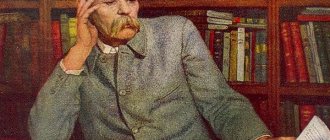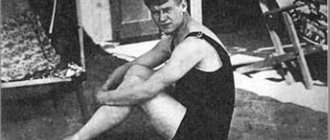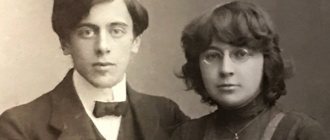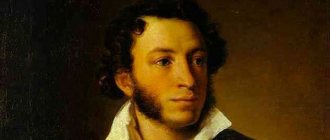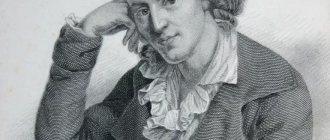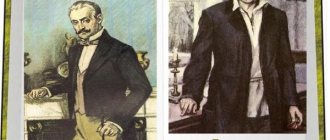Parents of Pavel Petrovich
Years of life and death of Pavel Petrovich 1879 - 1950.
The writer was born on January 27 in a family of workers in the city of Syset. The town belonged to the Yekaterinburg district and had the status of an industrial center.
The writer’s father was Pyotr Vasilyevich Bazhev (the parent’s surname was originally spelled with the letter “e”). This man worked, if translated into modern language, as a workshop foreman. His penchant for alcohol aroused an “evil tongue” in Pyotr Vasilyevich.
He criticized his own superiors, and it was because of this that he often quit his job. However, he was a knowledgeable and irreplaceable worker, so one day he was reinstated in his previous position. The next libation again left him without a job, which gave way to long persuasion to return him to service.
Mother was Augustina Stefanovna (nee Osintseva). She originally came from a family of Polish peasants. The woman did not have a permanent place of work; as is now commonly believed, she was classified as a housewife. She spent all day doing housework, and spent the evenings doing handicrafts.
By the way, she was a craftswoman and made knitted lace stockings for sale. These unique products were very popular among the wives of local authorities. This is what kept the family from falling apart during the frequent dismissals of Pyotr Vasilyevich from his position. Over the years, painstaking work in low light had a detrimental effect on the vision of the writer’s mother.
Childhood
Pavel was the only child in the family. The grumpy father treated his own differently from someone else's; he adored his son. Everything was allowed and forgiven for the future writer.
He was enveloped in the warmth and affection of both loving parents. They tried in every possible way to brighten up their son's childhood.
In the evenings, especially in winter, Pasha enjoyed tales about the working people of the Urals. He was fascinated by fantastic stories about the mistress of the local mountains, about a gold snake and mines containing valuable rocks and gems. These tales captivated the boy, awakening and shaping his imagination.
Literary heritage and its significance
Pavel Petrovich Bazhov wrote a total of 56 tales, published in various collections. These are the main works in the writer’s biography, and there are no analogues in our country and in the world to such a phenomenon as his original creativity. Of course, we can say that Ural tales belong to literary fairy tales, or to the treatment of folklore motifs and compare Bazhov with recognized masters of the pen in Russian literature of this direction - and these are Sergei Aksakov, Leo Tolstoy, Alexander Pushkin, Vasily Zhukovsky, Pyotr Ershov . Classification in the literature is needed.
But assignment to one genre or another is always somewhat arbitrary, and, moreover, does not in any way detract from the outstanding talent of the writer who created his own world, amazing and beautiful, so attractive that his works have been translated into more than 100 languages. His tales have been filmed many times, both in animation and in feature films, plays have been staged based on them, they have formed the basis of two ballets, an opera, and a symphonic poem.
Education and upbringing
The boy grew up as an intelligent and inquisitive youth. He easily and without extra effort graduated from a four-year primary school, which was located in his town. It so happened that a volume of Pushkin’s poems that accidentally fell into the boy’s hands was learned by heart.
The writer recalled that the librarian, giving him the book, jokingly demanded that the boy learn the volume by heart. The dutiful child did not take the joking tone and learned everything as he was told.
This fact amazed his teacher. He, having talked with the boy’s parents, persuaded them to send their son for further education, seeing the student’s enormous potential. Having learned about the deplorable state of the family, he took everything into his own hands. The teacher took Pavel to Yekaterinburg and introduced him to his friend, who works as a veterinarian.
This man's name was Nikolai Smorodintsev. It was he who oversaw the young man’s education in subsequent years, and later became a loyal friend. It was to this man that Bazhov owed the chance to continue his studies.
Seminary studies
Having acquired the patronage of Nikolai Semyonovich Smorodintsev, at the age of ten Pavel easily entered the seminary, which was located in Yekaterinburg. This educational institution had the lowest tuition fees, so we chose it. Renting a house for the family was impossible due to the deplorable financial situation, so the veterinarian offered his hospitality to the boy.
The big city amazed the boy; the multi-story buildings built of stone were especially memorable. The young man was also amazed by the railway, popularly called cast iron. The cultural life of this city attracted the newly minted student with its colors.
After studying for some time, the young man was provided with other housing by the school. For these needs, the educational institution rented several rooms in a private house for nonresident students. A special person (inspector) was assigned to the group of young people. He kept order in the hostel.
At first the guys disliked this man, but later the writer spoke warmly about him. The inspector was an educated man, although a strict official. He instilled in the children a love of literature, often reading them stories by Kuprin, Tolstov and Gogol.
Pavel did well in his studies and had the best grades. The student spent his summer holidays at home with his parents. In the evenings, with the rest of the boys, he ran to the warehouses for storing firewood. Vasily Alekseevich Khmelin worked there as a watchman. Among the guys they called him Grandpa Sunny.
He attracted young people with his unusual stories in the genre of folklore and fantasy. This man knew how to tell stories very well, his stories were easily and long remembered. It was these Ural tales that colored the writer’s subsequent works in a unique light. Subsequently, it was this circumstance that aroused interest in collecting local folklore, figures of speech, fairy tales and legends of these places.
Upon completion of his studies, the young man was offered to enter the theological seminary, but he refused. He was frightened by the fact that he would have to leave for Perm, separating himself a greater distance from his family. He also did not feel any inclination towards spiritual activity.
Pavel shared more revolutionary views, so he decided to stop his education there. During his student years, he read forbidden revolutionary literature and was interested in philosophy and the works of Darwin. This determined his future fate.
Teaching activities
I tried to enter a secular university and failed. This prompted Pavel to take up teaching. A factor that influenced this decision was the mother, who lost her sight and was left alone after the death of her father. She needed help, including financial support.
Pavel Bazhov (standing on the left in the photo) with fellow teachers
At first, the young man took up tutoring. His earnings also came from writing articles for newspapers. This man subsequently worked as a teacher for a total of about 20 years. The path of teaching the native language began in the village of Shaidurikha, which was located not far from the city of Nevyansk.
Then he worked at the Kamyshlov Theological School, and subsequently studied at the diocesan educational institution for girls, located in Yekaterinburg. As a teacher he was attentive and kind, this contributed to the adoration of his students. Pavel Petrovich's lessons were the most favorite subject among students.
During this time, Bazhov did not stop collecting Ural figures of speech, quotes, riddles, folklore and fairy tales. When sending students on summer vacation, they were given the task of learning and writing down everything connected with it. The teacher carefully recorded all the information.
Subsequently, becoming one of the most famous folklorists of his time, he did a lot of work in this field, independently looking for interesting words, proverbs and sayings. The dialectical expressions collected and used in works can only be found in modern dictionaries.
Pavel Bazhov - personal life
As already reported above, until the age of 32, Pavel Bazhov was not seen in any serious relationships. He was completely immersed in teaching and revolutionary activities. Judging by the writer’s character, he was waiting for that very true love. In his case, the expectations were not in vain.
Valentina Alexandrovna and Pavel Petrovich shortly after the wedding
Creativity of P. P. Bazhov
In the 20s of the last XIX century. a move took place from Kamyshlov, where the Bazhov family had lived until that time, to Yekaterinburg. In a big city, Bazhov worked in print publications. Four years later, Bazhov released his first collection, which turned out to be very popular among readers. The book was called “The Ural Were.”
Work on these tales was carried out in free time, after the main work activity. Creative activity was not a burden to the writer; it was always done with pleasure. The authorities, noting Bazhov's success, ordered the following literary works. From the author’s pen of Pavel Petrovich came such stories as: “Towards calculation”; “For Soviet truth”; “First draft fighters” and others.
In the 30s, the purge of the ranks of power was in full swing, and the writer did not escape the same fate. In 1937, the writer was accused of being loyal to Trotsky and was deprived of his party card and job.
Left out of work, Bazhov took up writing fairy tales, remembering the stories of Grandfather Sunny and finding solace in this activity. By this time, the children had grown up and helped keep the family afloat. Everyone worked and had a stable income.
In 1937, Bazhov’s first book of fairy tales, “The Malachite Box,” was published.
The success of these stories was enchanting; the collection was immediately swept off the shelves of second-hand bookstores.
The resulting excitement for this book literally revived the writer’s spirit. The stories that Bazhov collected in the Urals and then published were close to the local population.
After the start of the war, the writer worked on publishing almanacs. This was done to raise the morale of the people serving on the front line. True, this did not last long; the writer’s vision began to decline sharply. After this, Bazhov occupied himself with lecturing, and subsequently headed the writers' organization in the city of Sverdlovsk.
Bazhov's creativity
There would be no happiness...
It is interesting that it was thanks to the second expulsion from the party that the author of Ural fairy tales was born. The fact is that by this time Bazhov was already a well-known correspondent, had extensive experience in publishing, and published his works and monographs. But because of the denunciation, he not only became a non-party member, but also lost his position at the publishing house, and he was not hired for a new job.
At this time, the family lived very hard; only the wife’s sister, who worked as a teacher, earned money. Pavel Bazhov was burdened by this situation, but he could not do anything. And in order not to sit idle, in addition to housework and housework, he decided to arrange the Ural tales, which he had been collecting for many years in a row.
Where it all began
The impetus for the creation of the collection was such an incident. At the time when Bazhov headed the newspaper, he participated in discussions on the topic of oral folk art. The young Soviet government wanted to publish a collection of workers' and collective farm-proletarian folklore. The person appointed to the post of editor of this collection failed to cope with the task, and Pavel Petrovich came to replace him.
Bazhov at work... Photo source: www.bazhov.ru/
To be fair, it must be said that Pavel Bazhov collected legends and epics not as a folklorist scientist, but as a writer, that is, he essentially did not follow all the rules for collecting folklore data: he did not carry out certification and could often “remake” a fairy tale if it had heroes did not glorify Russia or the Urals. He honestly admitted that he rejected everything that was not in favor of his homeland. Later, he was even accused that the writer did not write down ancient folk tales and epics, but composed his own. But, as time has shown, even if this was partly true, Russian literature was enriched due to the author’s imagination.
Valentina Alexandrovna helps her husband. Photo source: www.bazhov.ru/
“The Malachite Box” and other tales by Pavel Bazhov
The first publication of Ural tales took place in 1936. The fairy tale “The Girl of Azovka” was published. Three years later, the collection “The Malachite Box” was published, which the author replenished with new epics throughout his subsequent life. It is here that the character Grandfather Slyshko appears, whose prototype was the Ural old-timer Vasily Khmelenin. The tales were signed as follows: “Recorded by P. Bazhov.”
After the release of the collection, the author began to be nagged: what, exactly, was his merit if he simply wrote down his grandfather’s stories? Later, critics changed the direction of their attacks: since the tales are the author’s fiction, it means they are falsifications. The poet Demyan Bedny stood up for Bazhov.
Today it is already obvious to everyone that Bazhov’s work cannot be limited only by the term “processing of folklore”; it is completely independent. It’s just that its basis lies in folk legends. Just like in Goethe's Faust or Pushkin's The Stone Guest, the ideas of which the authors drew from ancient stories.
With a copy of the book “The Malachite Box”. 1939 Photo source: www.bazhov.ru/
This is how one of his biographers described the significance of Pavel Bazhov’s work:
Pavel Bazhov carried out significant (and very large) work in relation to the language of tales. He did not want to slip into the vernacular typical of craftsmen, but he also did not want pompousness or popular print. Pavel Petrovich carefully studied the works of his predecessors, especially Nikolai Leskov and Ivan Gorbunov.
1st ed. books “Malachite Box”, 1939 Hood. A. A. Kudrin
As a result, he was able to develop his own unique style and language, which combined both patterned folk speech and the clarity, harmony, and expressiveness of his own Bazhov style. His descriptions of his native land are very heartfelt:
Russian postage stamp for the 125th anniversary of the birth of Pavel Bazhov.
List of famous works
The books are written in a language that everyone, young and old, understands. The best artists have worked and continue to work on the illustrations.
Attention is paid to Ural motifs. In the works, the description of the life of the ordinary population of the Urals is captivating. The heroes are ordinary workers.
Here is a list of Bazhov's most famous works:
- "Mining Master";
- "Two lizards";
- "Snake's Trail";
- “About the Great Snake”;
- “Mistress of the Copper Mountain”;
- "Stone Flower";
- "At the old mine";
- "Cat's ears";
- “Sinyushkin Well”;
- "Silver Hoof";
- "Jumping Firefly."
Published books still attract all segments of society. They have been translated into a large number of languages around the world.
The writer's main work
The publication of Bazhov’s book “The Malachite Box” (1939) largely determined the writer’s fate. This book brought the writer world fame. Bazhov’s talent was most clearly demonstrated in the tales of this book, which he constantly updated. “The Malachite Box” is a collection of folklore stories for children and adults about life and everyday life in the Urals, about the beauty of the nature of the Ural land.
The “Malachite Box” contains many mythological characters, for example: the Mistress of the Copper Mountain, the Great Snake, Danila the Master, Grandma Sinyushka, the Jumping Ognevushka and others.
In 1943, thanks to this book, he received the Stalin Prize. And in 1944 he was awarded the Order of Lenin for his fruitful work.
Pavel Bazhov created many works, on the basis of which ballets, operas, plays, films and cartoons were made.
Writer's personal life
Purposefulness in study and work led to the fact that the writer tied the knot quite late. He married his former student Valentina Ivanitskaya at the age of 32.
Despite the large age difference (the girl was 19 at the time of marriage), these people idolized each other. They carried tender and reverent love until the end of their lives.
The marriage produced 7 children, although only half of them survived (Olga, Elena, Ariadna and Alexey), three more died in infancy. A big loss was the sudden death of my son at a fairly young age. At the factory where Alexey worked, a disaster occurred that claimed the life of the only male heir. The whole family was grieving the loss.
Last years of life and death
Having become a deputy of the USSR, Pavel Petrovich Bazhov worked tirelessly. This man gave all his strength to his homeland. He even spent his personal time helping people in need. He participated a lot in improving the life of ordinary workers and tried to help the needy sections of society. Having a gentle and gentle character, he acquired a lot of loyal friends.
Shortly before his death, he stopped writing. He died at the age of 72 from lung cancer in 1950.
He was buried in the city of Yekaterinburg.
According to the recollections of the writer’s youngest daughter, Ariadna Pavlovna, her father was buried on a hill from which one can see the expanses of the Urals, so beloved by her father.
Death and legacy of Bazhov P.P.
The writer's life was cut short on December 3, 1950. The writer was buried in Sverdlovsk at the Ivanovo cemetery.
In the writer’s hometown, in the house where he lived, a museum was opened.
A folk festival in the Chelyabinsk region, an annual prize awarded in Yekaterinburg, is named after the writer. Commemorative monuments were erected to Pavel Bazhov in Sverdlovsk, Polevsky and other cities. Streets in many cities of the former USSR are also named after the writer. Read Bazhov's tales. Contents Biographies of other writers and poets


